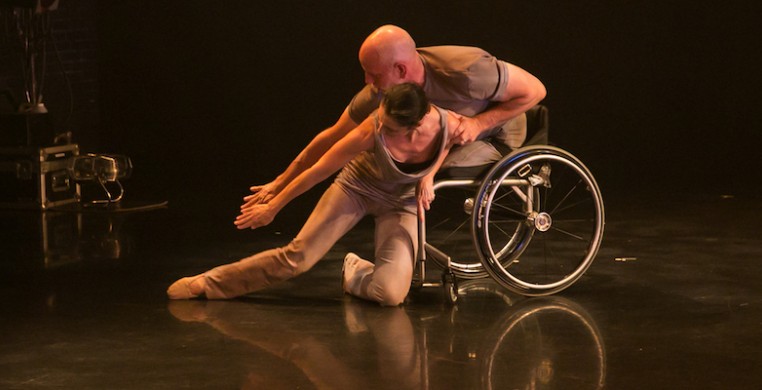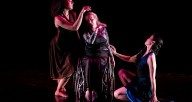I left last night’s performance of “Counter Balance: The Power of Integrated Dance” with words like “poetic,” “challenging," “arresting,” and “inspiring” floating through my thoughts, and with an ultimately heartwarming affirmation of the power of dance to ennoble our humanity.
If you have even the least inclination to champion physical diversity on stage, try to catch today’s final performance of Momenta’s “Counter Balance,” at 3 p.m. at the Center on Halsted. You’re in for a treat.
Integrated dance is the artistic integration of dancers with and without disabilities in concert dance choreography, not to be confused with dance therapy.
The physically integrated dance movement has been developing across the globe at least since the early 1960s. In the U.S., Dancing Wheels, established in Cleveland, Ohio in 1980, was the first professional company in America to stage choreography that integrates dancers with and without disabilities. California’s Axis Dance Theatre Company, established in 1987, aspires to “change the face of dance and disability,” and has been a pioneer in engaging prominent contemporary dance choreographers, including Bill T. Jones, Yvonne Rainer, and Joe Goode, to develop works for its integrated dance ensemble. New York-based Heidi Latski Dance, employing a diverse range of dancers with and without disabilities since 2001, seeks to “redefine beauty and virtuosity through performance.” Together, along with a growing number of companies incorporating professional dancers with disabilities, they are paving the way for integrated dance to become its own genre of concert dance.
Here in Chicago, Momenta, under the artistic direction of Stephanie Clemens and Ginger Lane, began incorporating repertoire to include dancers with disabilities in 2003.
“Counter Balance,” now in its ninth year and co-produced by Momenta and Access Living, is an annual concert showcasing integrated dance works by nationally and internationally-known dancers and choreographers with and without disabilities.
The collection of eleven works (too many for an evening that found ample anchor in three substantial group pieces, three duets and a rousing full-company finale) showcased a magical blend of bodies propelled by limbs and wheels.
Alice Sheppard’s quintet, “I Belong To You” (2014/2019), opened the program with a lyrical portrait of mutable relationships, set to a commissioned score for cello and violin by Joan Jeanrenaud. It’s easy to enjoy this breezy mix of couples, trios and ensemble partnering, a perfect opener to introduce the truly integrated blend of locomotion that “Counter Balance” so beautifully exemplifies. Especially striking is the continuum of line and flow in arcs, swoops, reaches and spirals, the dancers’ spines propelling a twirling melange of bodies on wheels and on foot.
Statuesque Stephanie Clemens began Sarah Cullen Fuller’s gorgeous piece, “Queens” (2019), seated in a stationary chair. Her poignant physical storytelling recalled the impassioned simplicity of Martha Graham’s “Lamentations” and “Divine Ruth” (St. Denis) in her elegant musical visualization of her relationship to the four younger women in her life, past and present. Set to a section of Bach’s St. Matthew Passion, the haunting combination of voice and violin lent the quality of memory to the groupings of the five ladies, their fleeting encounters interlocking wheelchairs and encircling each other only to separate.
Three male/female duets comprise a mid-program triptych of different stages in relationships.
Sarah Najera’s “Duet In C Major” (2019), is a good old-fashioned love duet, charmingly danced by a balletic Julia Cox on foot and the charming Robby Williams in wheelchair, supporting her in the best of cavalier prince tradition. Cox’s arm-circles mirror Williams’ wheels, the two dancers spinning in a tandem of affection and playful discovery. Najera’s musicality in her movement phrasing for Williams added pleasing texture to the overall spatial design.
Anita Filmore Kenney and Kris Lenzo's “Indecision” (2007) pits the two co-choreographers on stage in a prickly breakup and reconciliation filled with confrontation, conflict, and bittersweet realization. Lenzo’s ability to emote volumes in nothing short of virtuoso timing, dynamics and technical use of his instrument—both body and chair— is breathtaking.
Striking visual design defines much of “An Intimate Duet,” choreographed and performed by Israeli guest artists Hai Cohen in chair and Tali Wertheim on his lap and on foot. Disembodied arms fold and unwrap around Wertheim before Cohen’s face and body finally emerge from behind her. This sensual partnering evolves slowly, meticulously, its beauty in the poetic simplicity of each gesture, the parameters of physical limitation opening up infinite possibilities for movement invention.
Clarinetist James Falzone was the sixth “dancer” in Alice Sheppard’s quintet “Re-Membering a World to Come” (2016/2019), exploring the history of disabled people in the Holocaust, particularly in connection to lead dancer Ginger Lane’s personal life experience. Lane begins the piece alone, her torso and one arm draped over the side of her motorized chair, with Falzone at first seated on the floor off to the side. Her breath summons four other dancers from the wings like phantoms she has conjured from a dream. She encircles them in a luscious syncopation with the Falzon’s music as he rises and interacts with them. The music itself becomes one of the characters, summoning her back in memory and in space. Just as her memories came alive with her breath, it is her breath that collapses them to conclude a piece driven by compelling need, sorrow, and compassion.
--
"Counter Balance" concludes today at 3 p.m. at the Center on Halsted, 3656 N. Halsted St. For tickets and more information, click the event page below.


